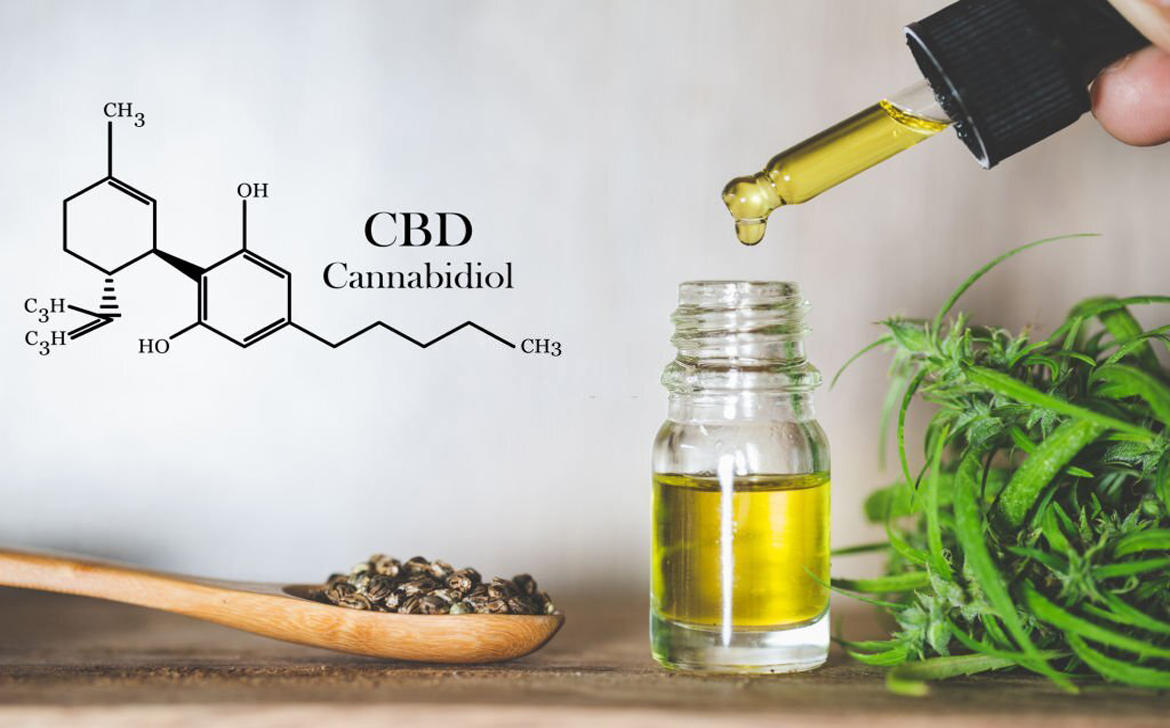History of Medicinal Cannabis
For thousands of years, humans have used natural products to provide fibers, food, and medicine, among which Cannabis Sativa stands out. Various civilizations throughout the ages cultivated Cannabis to obtain its extracts and fibers. In addition to its medicinal attributes, its psychoactive properties were commonly referenced as capable of promoting spiritual elevation in sacred rituals. Thus, the cultivation and consumption of Cannabis by humans span almost 10,000 years, from the representation of the goddess Sechat in ancient Egypt, to the medical writings of Emperor Shen Nung in China, as a sacred plant mentioned in the Hindu Atharva Veda, or even as a component of Christian sacred oil.
Given its promising medicinal properties, in 1899, the first cannabinoid from the plant, Cannabinol, was isolated. Years passed, and in the 1960s, Israeli researcher Raphael Mechoulam isolated and identified the structures of CBD and THC, the main cannabinoids of the plant. The pharmacological action of cannabinoids intrigued researchers, and in the early 1990s, after much research, the Endocannabinoid System (ECS) was elucidated, bringing new hope.
Endocannabinoid System
Just as we have a digestive system and a circulatory system, we also have the Endocannabinoid System (ECS). The ECS can be defined as a neuromodulator system and plays various regulatory functions, including cognition, appetite control, and analgesia, mediating neuronal plasticity and neurogenesis. Unlike other systems with well-established primary organs, such as the stomach or heart, the ECS does not have a primary organ; it is present in various parts of the body and consists mainly of two primary receptors from the G-protein-coupled receptor family: cannabinoid receptors 1 and 2 (CB1R and CB2R), and two primary endogenous cannabinoids (endocannabinoids): N-arachidonoylethanolamine (anandamide) and 2-arachidonoylglycerol (2-AG), as well as the enzymes responsible for their metabolism.
The ECS acts as a regulator in the physiological mechanism of various functions of the human body, such as:
>> Energy Balance Control
>> Nutrient Transport
>> Thermoregulation
>> Metabolism
>> Inflammation
>> Emotion
>> Reproduction
>> Muscle Control
>> Stress
>> Mood
>> Memory
>> Pain
>> Appetite
CB1 Receptor
CB1 cannabinoid receptors are widely distributed throughout the body but are mainly concentrated in the central nervous system, being the primary G protein-coupled receptor in the human brain. Responsible for areas related to motor control, learning, memory, cognition, and emotion, CB1 plays an essential role in neurological diseases, ataxias, pain perception, appetite, and movement dysfunction. The CB1 receptor is also linked to the psychotropic effects of cannabinoids, and it is this receptor to which THC binds.
CB2 Receptor
CB2 cannabinoid receptors, like CB1, are spread throughout the body but are mainly concentrated in organs and cells associated with the immune response. The modulation of CB2 is linked to the release of cytokines, migration of immune cells, and consequently, the response to inflammations as seen in diseases such as Parkinson's, Alzheimer's, Huntington's, among others.
Anandamide
Anandamide is a partial agonist of both CB1 and CB2 receptors but has shown a higher affinity for CB1. It is synthesized in areas of the brain that are important for memory, motivation, motor control, and higher thought processes. It has also been found that Anandamide plays a significant role in fertility, anxiety, pain, and appetite. Anandamide is synthesized by the enzyme NAPE and degraded by FAAH. Its name derives from the Sanskrit word "ananda," which means "happiness" or "extreme pleasure," and it was named as such by the scientists who discovered it.
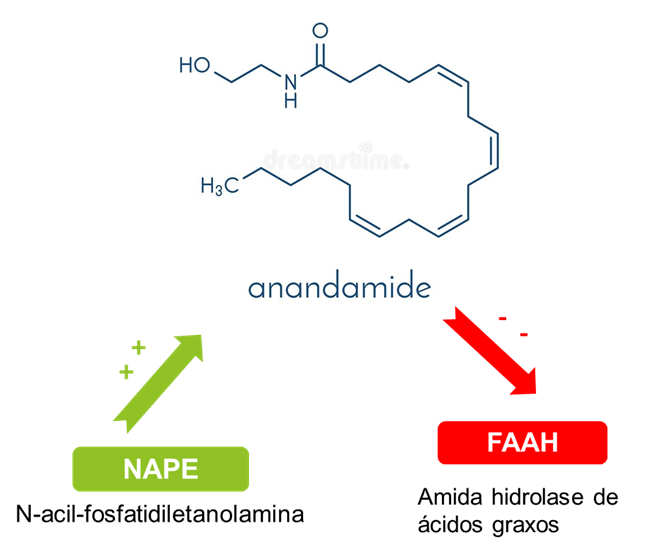
2-Arachidonoylglycerol (2-AG)
2-AG has been shown to be a full agonist of both CB1 and CB2 receptors. It is the primary binding molecule for the CB2 receptor, playing an important role in regulating the immune system and pain management. 2-AG is synthesized by DAGL and metabolized by MAGL.
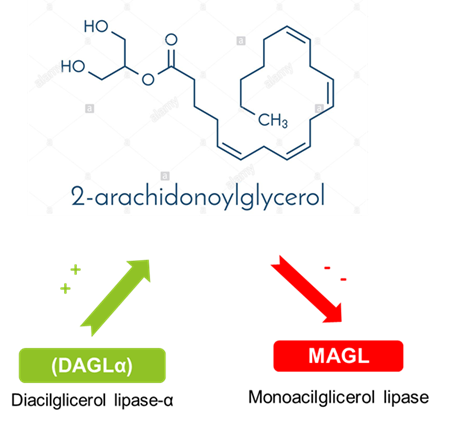
Phytocannabinoids
In addition to the natural cannabinoids in the brain, CB1R and CB2R act as receptors for different external cannabinoid ligands. The plant Cannabis sativa (commonly known as marijuana) has been used by humanity for over 10,000 years due to its fibers, medicinal properties, and psychoactive effects associated with spirituality. Marijuana contains more than 60 pharmacologically active cannabinoids (phytocannabinoids) identified so far, among them Δ9-tetrahydrocannabinol (THC), the main psychoactive compound of the plant, and cannabidiol (CBD), the main non-psychoactive compound of the plant. These and other compounds found in C. sativa are being extensively studied for their immunomodulatory and neuroprotective characteristics in the treatment of symptoms of diseases such as Parkinson's, Alzheimer's, Multiple Sclerosis, autoimmune diseases, cancers, and recently for COVID-19.
In addition to THC and CBD, Cannabis contains a diverse range of flavonoids, terpenes, and other bioactive molecules that contribute to its pharmacological activities, enhancing its medicinal effects in what is known as the entourage effect.
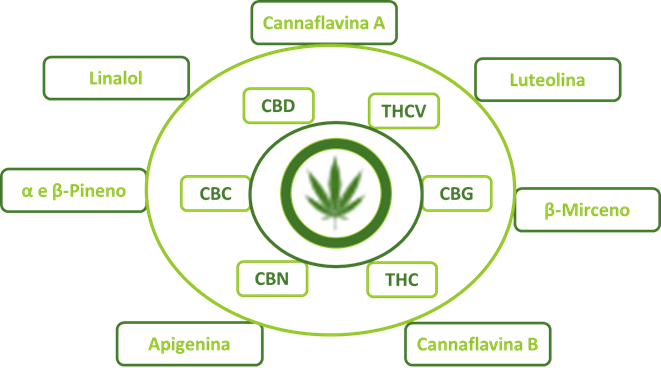
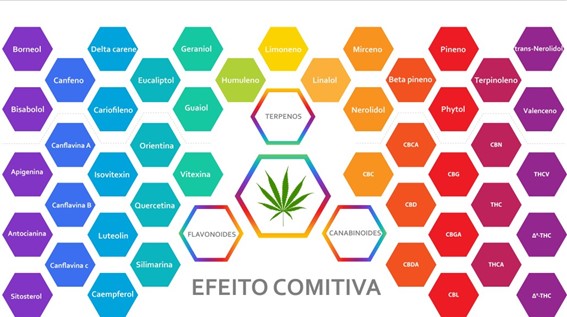
Cannabidiol - CBD
CBD was isolated in 1940, and its structure was elucidated in 1963. As the main non-psychoactive component of the plant, CBD has emerged for the treatment of symptoms of various chronic, neurological, and psychiatric diseases. CBD does not strongly interact with cannabinoid receptors, and its action in this system mainly occurs by blocking the reuptake and/or endogenous hydrolysis of the endocannabinoid anandamide. Despite not interacting as strongly with CB1 and CB2, CBD is capable of modulating various other receptors, acting as a "promiscuous" molecule and thus leading to an improvement in the overall health of the patient.
Among its actions:
>> Analgesia by reducing neuronal excitability
>> Antioxidant
>> Anticonvulsant
>> Anti-inflammatory
>> Anxiolytic via 5-HT receptor
>> Hypoglycemic
>> Neuroprotective
>> Immunomodulator
Δ-9-Tetrahydrocannabinol - THC
THC had its structure isolated and identified in 1964. THC is an agonist of the CB1 receptor and is mainly responsible for the psychoactive effects of the plant. THC is also associated with many of the medicinal properties of cannabis and can be used to treat symptoms of various pathologies, including:
>> Increase in dopamine efflux
>> Treatment of chronic and neuropathic pain
>> Antiemetic
>> Appetite stimulant
>> Inhibition of the formation of pathological proteins in the brain
>> Glaucoma treatment
>> Palliative care
Cannabigerol - CBG
CBG is a non-psychoactive phytocannabinoid that is normally found in concentrations below 1%. It is the precursor substance of several other cannabinoids such as CBD, CBN, and CBC. CBG has an extremely potent effect on CB2 receptors, which are related to the functioning of the immune system and peripheral nerves.
CBG is also a potent agonist of PPARs, transition factors that signal inflammation within the cell nucleus. These factors act as messengers in antioxidant and anti-inflammatory processes in the body. When PPARs are activated, they stimulate the body to reduce inflammation and act as an antioxidant effect.
Cannabinol - CBN
Cannabinol or CBN is a compound derived from the oxidation of delta-9-THC. Therefore, it is usually present in higher quantities in cannabis extracts stored for a long time. CBN has shown great potential as an anti-inflammatory and antibacterial agent, but it has also drawn a lot of attention for its ability to modulate and maintain sleep, contributing to the relaxation of patients.
>> Improvement of sleep hygiene
>> Anxiety
>> Anti-inflammatory
>> Antibacterial


